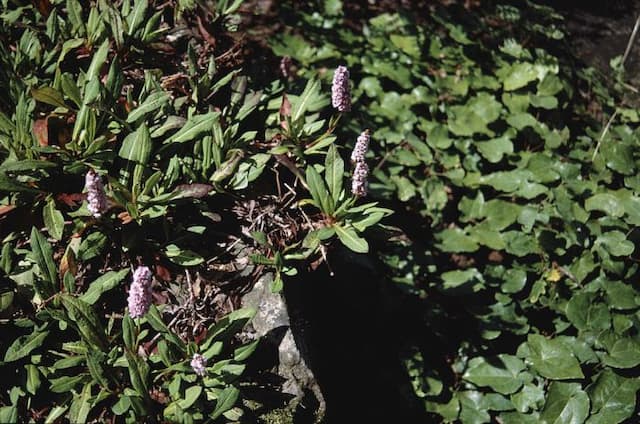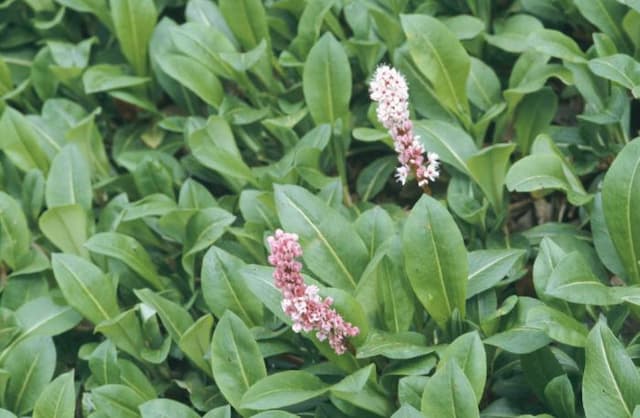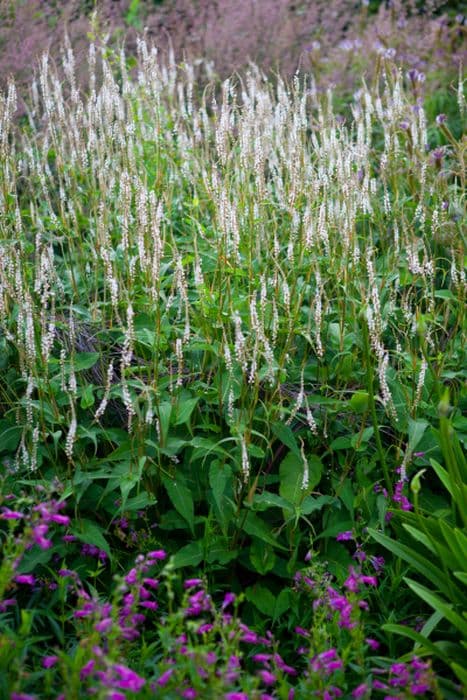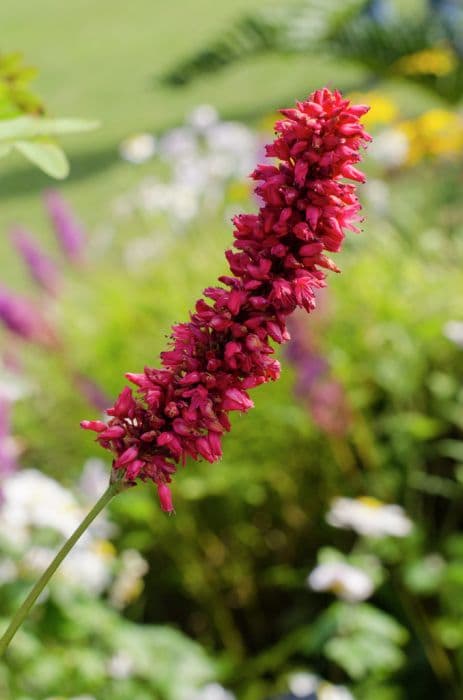Himalayan Bistort Persicaria affinis

ABOUT
The plant commonly known as Knotweed is a spreading, mat-forming perennial. It has a dense array of lance-shaped, dark green leaves that often take on a reddish-bronze hue in the fall, creating a shifting tapestry of color through the seasons. The leaves form a lush carpet of vegetation over the surface they grow upon. During the blooming period, Knotweed produces a profusion of dense, poker-like spikes of small flowers. These flowers range from a soft pink to deep crimson, adding a vivid splash of color to its foliage backdrop. Over time, the flower colors can intensify, further enhancing the ornamental appeal of the plant. The flowers themselves are arranged closely together on the spikes, each with a tiny pointed shape and often with a darker center that can give the overall spike a bicolored appearance. When it is not in bloom, the Knotweed's foliage still maintains interest due to its texture and seasonal color changes, making it an attractive ground cover throughout the year.
About this plant
 Names
NamesSynonyms
Himalayan Bistort, Fleece Flower, Knotweed, Smartweed.
Common names
Bistorta affinis, Polygonum affine, Persicaria campanulata, Polygonum brunonis.
 Toxicity
ToxicityTo humans
Himalayan bistort is not typically considered toxic to humans. There is no well-documented evidence of Himalayan bistort causing poisoning in humans, and it is not generally listed among plants known to have toxic effects when ingested. Therefore, accidental ingestion of small quantities is unlikely to cause harm. However, as with any plant, individual allergic reactions or sensitivities can occur, so it's prudent to exercise caution and avoid ingesting plants that are not commonly recognized as edible.
To pets
Himalayan bistort is also not commonly known to be toxic to pets. There is limited information on the effects of this plant on household animals, but it is not generally listed as a plant that is harmful to pets like dogs and cats. As with humans, ingestion of plant material by pets can sometimes lead to gastrointestinal upset or allergic reactions, so it is best to prevent pets from eating ornamental plants. If a pet ingests a large amount of any plant, including Himalayan bistort, and shows signs of illness, it is advisable to consult a veterinarian.
 Characteristics
CharacteristicsLife cycle
Perennials
Foliage type
Evergreen
Color of leaves
Green
Flower color
Pink
Height
1 foot (30 centimeters)
Spread
2 feet (60 centimeters)
Plant type
Herb
Hardiness zones
5
Native area
Himalayas
Benefits
 General Benefits
General Benefits- Low Maintenance: Persicaria affinis is known for being a low-maintenance plant, requiring minimal care once established.
- Ground Cover: It serves as an excellent ground cover, spreading easily and preventing weed growth.
- Erosion Control: Its robust root system helps stabilize soil and prevent erosion on slopes or banks.
- Attracts Pollinators: The plant's flowers attract beneficial insects, such as bees and butterflies, supporting local ecosystems.
- Ornamental Value: With its attractive foliage and flowers, it adds visual interest to gardens throughout the growing season.
- Drought Tolerant: Once established, it has a degree of drought tolerance, making it suitable for drier climates or water-wise gardens.
- Winter Interest: Persicaria affinis provides winter interest due to its semi-evergreen nature in milder climates.
- Adaptive: It can thrive in a wide range of soil types, from clay to sandy soils.
- Long Blooming: Its long blooming period from midsummer to fall ensures a prolonged display of color.
 Medical Properties
Medical PropertiesThis plant is not used for medical purposes.
 Air-purifying Qualities
Air-purifying QualitiesThis plant is not specifically known for air purifying qualities.
 Other Uses
Other Uses- Persicaria affinis, commonly known as the Himalayan bistort, can be used as a ground cover in gardens due to its dense mat-forming habit, which suppresses weeds.
- The plant's ability to stabilize soil makes it a good choice for planting on slopes and banks to prevent erosion.
- Himalayan bistort's vibrant blooms can be used to add color in flower arrangements or bouquets.
- Some cultures may use the robust leaves of the Himalayan bistort in crafting, such as for lining baskets or weaving small items.
- Because the plant holds water well, it can be used in rain gardens to manage excess water runoff.
- The plant's extensive root system makes it suitable for use in permaculture as a natural means of aerating the soil.
- In frost-prone areas, the Himalayan bistort might serve as an indicator plant as it is sensitive to early frost, which can signal gardeners to protect other sensitive plants.
- The dried seed heads of Himalayan bistort can add an interesting texture to dried flower arrangements, extending the usefulness of the plant beyond the growing season.
- The flowers of Himalayan bistort can be collected to produce natural dyes for textiles, offering a range of colors from browns to soft yellows.
- For educational purposes, the plant can be used to teach about plant propagation, as the Himalayan bistort can be easily propagated through division.
Interesting Facts
 Feng Shui
Feng ShuiThe plant named Himalayan bistort is not used in Feng Shui practice.
 Zodiac Sign Compitability
Zodiac Sign CompitabilityThe Himalayan bistort is not used in astrology practice.
 Plant Symbolism
Plant Symbolism- Connection: Persicaria affinis, commonly known as knotweed, often symbolizes connection due to its robust rhizomatous root system that can spread and connect plants over a large area.
- Perseverance: Knotweed's ability to thrive in various soil types and environmental conditions represents the tenacity and adaptability of an individual to persist through challenges.
- Unity: The dense, mat-forming character of knotweed reflects the concept of unity, as the plant grows closely together, symbolizing the strength and support found in coming together.
 Water
WaterThe Persicaria affinis, commonly known as the Himalayan bistort or fleeceflower, should be watered deeply once a week during active growing periods, ensuring the soil remains moist but not waterlogged. During the summer or in drier climates, check the soil moisture frequently, it may require additional watering if the soil dries out quickly. Approximately one to two gallons per square yard per week should suffice for mature plants. Adjust the amount of water during the fall and winter when the plant goes into dormancy, as it will require less. Avoid overhead watering to reduce the risk of foliar diseases.
 Light
LightThe Himalayan bistort thrives best in full sun to partial shade. It can adapt to a variety of lighting conditions but will produce the most abundant blooms when exposed to ample sunlight. An ideal spot would be one where the plant receives at least four to six hours of direct sunlight per day, possibly with some light afternoon shade in very hot climates.
 Temperature
TemperatureHimalayan bistort is hardy and can survive in temperatures as low as -20°F, making it suitable for many temperate climates. This perennial prefers a temperature range between 60°F and 75°F for optimal growth. While it can tolerate a summer temperature up to 85°F, it's important to ensure adequate moisture if temperatures frequently exceed this range.
 Pruning
PruningTo encourage denser growth and enhance blooming, prune Himalayan bistort in early spring before new growth starts. Cut back the faded flower spikes after blooming to keep the plant tidy and potentially encourage a second flush of flowers. If the plant becomes overcrowded or too large for its space, divide it in spring or fall, which also serves as an effective form of pruning.
 Cleaning
CleaningAs needed
 Soil
SoilHimalayan Fleeceflower thrives in rich, well-draining soil with a pH of 6.0-7.0. A soil mix of garden loam, peat or compost, and sand or perlite in equal parts creates an ideal environment for growth.
 Repotting
RepottingHimalayan Fleeceflower rarely needs repotting as it prefers to spread out; division or repotting can be done every 3-5 years to manage size.
 Humidity & Misting
Humidity & MistingHimalayan Fleeceflower tolerates a wide range of humidity levels but prefers moderate humidity, without special requirements for indoor cultivation.
 Suitable locations
Suitable locationsIndoor
Place in bright indirect light; water well.
Outdoor
Plant in partial shade to full sun; mulch well.
Hardiness zone
4-9 USDA
 Life cycle
Life cycleThe common name for Persicaria affinis is Himalayan bistort. The life cycle of this perennial plant begins with seed germination, typically occurring in a moist and shaded environment. Once the seeds have sprouted, the seedlings grow into mature plants, developing a dense mat of foliage with a creeping habit. Himalayan bistort produces spikes of small pink flowers that bloom from summer to fall, attracting pollinators and aiding in the reproductive cycle. After pollination, seeds are produced and dispersed, either by wind, water, or animals, allowing for the colonization of new areas. During winter or in cold climates, the plant may die back to the ground, surviving as underground rhizomes and regrowing in the spring to complete its life cycle.
 Propogation
PropogationPropogation time
Spring to summer
The most popular method of propagating Persicaria affinis, commonly known as the Himalayan bistort or fleeceflower, is through division. This is typically done in the spring or fall when the plant is not in active growth. To propagate by division, you should gently lift the clump of the plant from the ground using a garden fork, taking care not to damage the root system. Once the plant is lifted, you can divide it into smaller sections by either teasing apart the roots gently with your hands or cutting through them with a sharp knife or spade, ensuring each new section has a portion of roots attached. These individual sections can then be replanted into well-prepared soil, spacing them about 12 to 15 inches (approximately 30 to 38 centimeters) apart to allow enough room for growth. Water the new plantings thoroughly to help establish them. This method is advantageous as it helps to rejuvenate older plants, control their spread and produce new plants that will be exact clones of the parent.





![Red bistort [Taurus]](/_next/image?url=https%3A%2F%2Fplants-admin.emdemapps.com%2Fimages%2Fplants%2F%2Fimages%2F604b548be7841.png&w=640&q=75)



